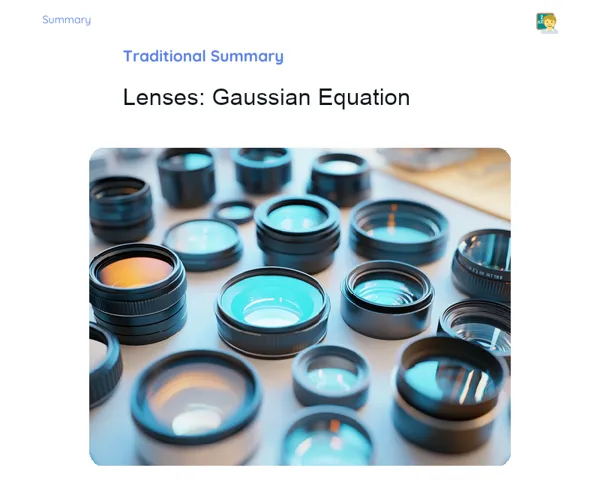Summary Tradisional | Electricity: Capacitance
Contextualization
Electricity is an integral part of our everyday life, powering everything from the mobile phones and computers we rely on, to the systems that transmit and distribute electrical energy across our cities. In this vast domain, capacitors hold a vital place. They are electrical components designed to store and release energy in a controlled way, ensuring the stability and efficiency of various electrical systems. You can spot them in a range of devices, from basic electronic gadgets to sophisticated medical equipment like defibrillators.
Capacitance, in simple terms, is the property of a capacitor that determines its ability to store an electric charge. Grasping the concept of capacitance and learning how to calculate it is a must for any physics student, particularly those with an interest in electronics or electrical engineering. In this lesson, we delve into the meaning of capacitance, lay out the basic formula for its calculation, explore the different types of capacitors and their real-life applications. This not only deepens theoretical understanding but also equips students with practical techniques to solve everyday problems related to electricity.
To Remember!
Definition of Capacitance
Capacitance refers to the ability of a system to store electrical charge. This is essentially how much charge a capacitor can hold when a certain potential difference (voltage) is applied across its plates. The SI unit of capacitance is the Farad (F), in honour of the great scientist Michael Faraday.
The capacitance value depends on factors like the area of the capacitor’s plates and the distance between them—the larger the area and the smaller the gap, the higher the capacitance. For a basic parallel plate capacitor, the formula is C = ε₀ * (A/d), where C represents the capacitance, ε₀ is the permittivity of free space, A is the area of the plates, and d is the distance between them.
Apart from the size and spacing of the plates, the dielectric material that lies between them also plays a crucial role. Different materials have varying permittivities which can either boost or diminish the charge-storing capacity. This concept is essential when it comes to designing and implementing capacitors in various applications.
-
Capacitance is the ability to store an electric charge.
-
The unit of capacitance is the Farad (F).
-
The basic formula is C = ε₀ * (A/d).
-
The dielectric material affects the capacitance.
Capacitance Formula
The capacitance formula connects the stored charge (Q) to the potential difference (V) across the capacitor’s plates. It is generally given by C = Q/V, meaning that capacitance is the ratio of the accumulated charge to the applied voltage.
For parallel plate capacitors, we use the formula C = ε₀ * (A/d), where ε₀ is the permittivity of free space (8.85 x 10^-12 F/m), A is the area of the plates, and d is the spacing between them. In capacitors with other shapes, such as cylindrical or spherical forms, the formulas differ slightly but the basic principle remains unchanged: the geometry and the dielectric material of the capacitor determine its capacitance.
A proper understanding of these formulas helps in calculating capacitance in practical scenarios, which in turn aids in the effective design and analysis of electronic circuits.
-
Capacitance is the ratio of charge to voltage (C = Q/V).
-
For parallel plate capacitors the formula is C = ε₀ * (A/d).
-
Both the geometry and the dielectric material influence capacitance.
Types of Capacitors
Capacitors come in various types, each with its own unique features and specific uses. The parallel plate capacitor is the simplest and is often used in classroom demonstrations. It consists of two conducting plates separated by a dielectric material.
Cylindrical capacitors feature two concentric cylinders, and their capacitance is calculated based on the radii of these cylinders along with the nature of the dielectric between them. Spherical capacitors, on the other hand, involve two concentric spherical shells, and here the capacitance depends on the radius of the spheres and the dielectric material involved.
Choosing the correct type of capacitor is critical, as it can affect the overall efficiency and functionality of an electronic circuit, whether it’s a simple hobby project or a complex industrial design.
-
Parallel plate capacitors are simple and widely used.
-
Cylindrical capacitors have two concentric cylinders.
-
Spherical capacitors consist of two concentric spherical shells.
-
The selection of a capacitor type depends on the particular application.
Energy Storage in Capacitors
Capacitors are designed to store electrical energy within the electric field formed between their plates. The energy stored, U, can be calculated using the formula U = 1/2 * C * V², where C is the capacitance and V is the potential difference across the plates. This stored energy is released quickly when needed, which is particularly helpful in many practical applications.
For instance, in cameras, capacitors store energy that is discharged all at once to power the flash. Similarly, in defibrillators, capacitors hold the energy required to deliver a powerful electric shock during a cardiac emergency.
This ability to store and rapidly release energy makes capacitors indispensable in numerous electronic devices and systems.
-
Energy stored in capacitors is given by U = 1/2 * C * V².
-
Capacitors can discharge their stored energy swiftly.
-
They are used in various applications including camera flashes and defibrillators.
Key Terms
-
Capacitance: The ability of a system to store electrical charge, measured in Farads (F).
-
Electric Charge (Q): The amount of charge stored in a capacitor.
-
Potential Difference (V): The voltage across the capacitor’s plates.
-
Permittivity of Free Space (ε₀): A constant that affects capacitance, with a value of 8.85 x 10^-12 F/m.
-
Parallel Plate Capacitor: A capacitor with two conducting plates separated by a dielectric.
-
Cylindrical Capacitor: A capacitor that uses two concentric cylinders.
-
Spherical Capacitor: A capacitor made up of two concentric spherical shells.
-
Dielectric: An insulating substance placed between the capacitor plates that influences its capacitance.
-
Stored Energy (U): The energy stored in a capacitor, computed using U = 1/2 * C * V².
Important Conclusions
In summary, this lesson has taken us through the concept of capacitance, defined as the ability of a system to store electrical charge, and explained its measurement in Farads. We learned that capacitance is affected by factors such as the area of the capacitor’s plates, the distance between them, and the type of dielectric material used. This knowledge is crucial for understanding how capacitors operate and are employed in electronic circuits.
We also reviewed the fundamental formulas for calculating capacitance, like C = Q/V for the relationship between the charge and voltage, and C = ε₀ * (A/d) specifically for parallel plate capacitors. Different capacitor types including parallel plate, cylindrical, and spherical were discussed, along with their real-life uses in various electrical and energy systems.
Finally, we highlighted the importance of energy storage in capacitors, with examples ranging from camera flashes to defibrillators. Mastering these concepts not only helps students solve theoretical problems but also prepares them to apply these ideas practically, thereby underlining the importance of studying capacitance in the realms of physics and electrical engineering.
Study Tips
-
Regularly revise the capacitance formulas and solve a variety of problems to build strong calculation skills.
-
Watch online videos and simulations demonstrating capacitor operations in circuits, which can help bridge theory and practical understanding.
-
Form or join study groups to discuss and solve complex problems, promoting better understanding through peer discussion.



